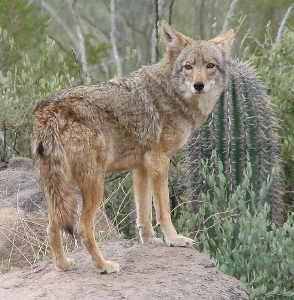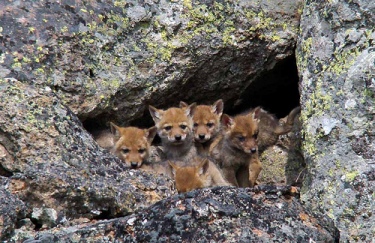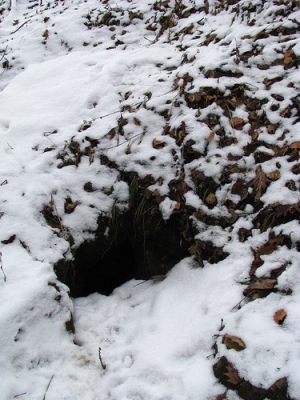
Where do coyotes live?

Perhaps a more appropriate question would be where don’t
coyotes live?
Coyotes can live in deserts, swamps, tundra, grasslands,
brush, dense forests, and even in large cities such as L.A., New
York, Phoenix and Denver. They thrive in grassland
habitats created by the removal of trees, where tall grasses
provide an ample supply of the small rodents that make up the
largest part of their diets. The coyote has been seen as
far south as Costa Rica and Panama and as far north as Alaska,
British Columbia, Saskatchewan and Alberta. The only areas that are avoided are the wet tropical
regions in the southern part of its range.
Early explorers only encountered coyotes west of the
Mississippi, but their habitats now reach all the way to New
England. Some researchers believe that coyotes have spread
to fill the niches vacated with the extermination of wolves in
areas of the United States and Canada. Still others
attribute their spread to pressure from humans and availability
of food.
The misconception of the coyote den
 Contrary
to what many people think, coyotes do not dwell in dens very
often. True dens are actually only used by pregnant
females to give birth in and for the pups to live in for a short
period while they are very young. The mother and other coyotes
seldom enter the den unless to bring food to the pups.
Dens are dug by the mating pair in sandy hillsides or stream
banks, or under rocky outcroppings or fallen logs where digging
is easy and the entrance can be protected and is easy to
watch. Coyotes have also been known to move into an
existing badger or fox den and enlarge it. In urban areas
coyotes use storm drains, dig under storage sheds, or dig holes
in vacant lots, parks or even golf courses.
Contrary
to what many people think, coyotes do not dwell in dens very
often. True dens are actually only used by pregnant
females to give birth in and for the pups to live in for a short
period while they are very young. The mother and other coyotes
seldom enter the den unless to bring food to the pups.
Dens are dug by the mating pair in sandy hillsides or stream
banks, or under rocky outcroppings or fallen logs where digging
is easy and the entrance can be protected and is easy to
watch. Coyotes have also been known to move into an
existing badger or fox den and enlarge it. In urban areas
coyotes use storm drains, dig under storage sheds, or dig holes
in vacant lots, parks or even golf courses.
Dens are usually three to six feet below the surface and can extend up to twenty-six feet into the hillside. The initial tunnel leads to
a large chamber, which often has a second entrance that is much
better hidden than the digging entrance. Because
of this second entrance and the wariness of adult coyotes,
active dens are extremely hard to find. Another
tactic coyotes use to protect pups is moving them between
multiple dens. This not only helps them avoid detection by
predators, but also because dens can accumulate fleas and other
parasites that can be a serious danger to the young. A coyote
will fiercely defend an active den if it believes the pups are
in danger. There have even been reports of mother coyotes
charging full-grown grizzlies whose paths came too close to a
den.
twenty-six feet into the hillside. The initial tunnel leads to
a large chamber, which often has a second entrance that is much
better hidden than the digging entrance. Because
of this second entrance and the wariness of adult coyotes,
active dens are extremely hard to find. Another
tactic coyotes use to protect pups is moving them between
multiple dens. This not only helps them avoid detection by
predators, but also because dens can accumulate fleas and other
parasites that can be a serious danger to the young. A coyote
will fiercely defend an active den if it believes the pups are
in danger. There have even been reports of mother coyotes
charging full-grown grizzlies whose paths came too close to a
den.
 Contrary
to what many people think, coyotes do not dwell in dens very
often. True dens are actually only used by pregnant
females to give birth in and for the pups to live in for a short
period while they are very young. The mother and other coyotes
seldom enter the den unless to bring food to the pups.
Dens are dug by the mating pair in sandy hillsides or stream
banks, or under rocky outcroppings or fallen logs where digging
is easy and the entrance can be protected and is easy to
watch. Coyotes have also been known to move into an
existing badger or fox den and enlarge it. In urban areas
coyotes use storm drains, dig under storage sheds, or dig holes
in vacant lots, parks or even golf courses.
Contrary
to what many people think, coyotes do not dwell in dens very
often. True dens are actually only used by pregnant
females to give birth in and for the pups to live in for a short
period while they are very young. The mother and other coyotes
seldom enter the den unless to bring food to the pups.
Dens are dug by the mating pair in sandy hillsides or stream
banks, or under rocky outcroppings or fallen logs where digging
is easy and the entrance can be protected and is easy to
watch. Coyotes have also been known to move into an
existing badger or fox den and enlarge it. In urban areas
coyotes use storm drains, dig under storage sheds, or dig holes
in vacant lots, parks or even golf courses. Dens are usually three to six feet below the surface and can extend up to
 twenty-six feet into the hillside. The initial tunnel leads to
a large chamber, which often has a second entrance that is much
better hidden than the digging entrance. Because
of this second entrance and the wariness of adult coyotes,
active dens are extremely hard to find. Another
tactic coyotes use to protect pups is moving them between
multiple dens. This not only helps them avoid detection by
predators, but also because dens can accumulate fleas and other
parasites that can be a serious danger to the young. A coyote
will fiercely defend an active den if it believes the pups are
in danger. There have even been reports of mother coyotes
charging full-grown grizzlies whose paths came too close to a
den.
twenty-six feet into the hillside. The initial tunnel leads to
a large chamber, which often has a second entrance that is much
better hidden than the digging entrance. Because
of this second entrance and the wariness of adult coyotes,
active dens are extremely hard to find. Another
tactic coyotes use to protect pups is moving them between
multiple dens. This not only helps them avoid detection by
predators, but also because dens can accumulate fleas and other
parasites that can be a serious danger to the young. A coyote
will fiercely defend an active den if it believes the pups are
in danger. There have even been reports of mother coyotes
charging full-grown grizzlies whose paths came too close to a
den.